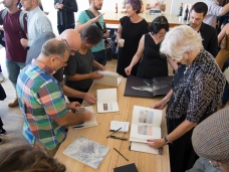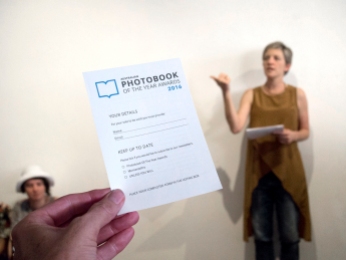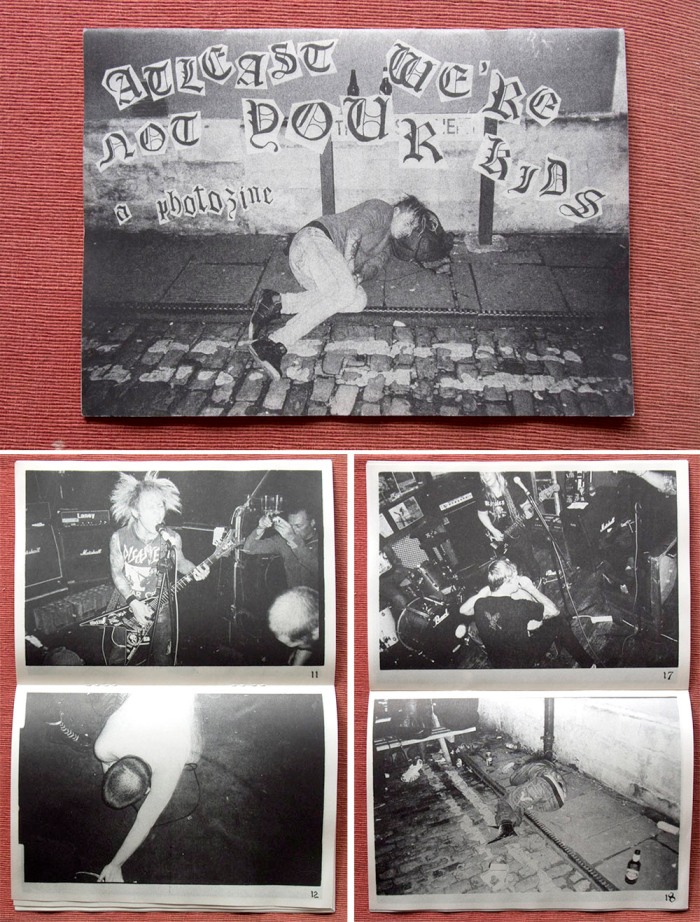Archive for February 2017
ZINES IN MELBOURNE: Sticky Institute’s Festival of the Photocopier
On Sunday 12 February the Melbourne Town Hall and was packed with sellers, lookers and buyers attending the Sticky Institute’s Festival of the Photocopier Zine Fair. At a guess, there could have been around 100 zine tables with a variety of zine-makers: both showing their own work, or representing other zinesters. For the visitor to the Fair there was an opportunity to see and handle almost any kind of communication that could put onto a sheet of paper, or into collated pages – folded, stapled, glued, stitched and sewn. Each ‘publication’ representing a personal approach to what the medium “zine” means to the author. And, as the ‘Zine’ is a slippery medium those within the discipline keep pushing the limits by integration of opportunistic technologies and ideas gleaned from contemporary media.
The content of the zines presented to us were from a broad church of visual and written media including: text as prose, poetry or as visual typographic forms, and calligraphy. There was a rich diversity of illustration from photo-realism to comic flat field work, photographs and even, in one sighted example – the ancient art of marbling. The narrative forms in these publications ranged from concrete poetry, prose, comic stories and disjointed stream of consciousness curated visuals.
In keeping with the tradition some zine makers aired their political opinions while others shared a fascination of contemporary everyday life. There were groups that concentrated on gender issues, music and issues of the street, while others presented dreamy naive and whimsical scenarios, adventures in suburbia, the road and outer space, nonsensical ghoulish and vampire episodes.
Our specific interest were zines based on or utilising photos sometimes referred to as photozines, as well as others that use photomontage in their narrative or conceptual work. Examples seen dealt with topics like the destruction of traditional family homes in the Chinese city of Guangzhou, skateboard stories, and a faux streetscape made up of photos of distressed buildings.
The Fair was a place to network. Greetings were made with like-minded people across the display tables and discussions took place about zines, life and art. We caught up with a few people we knew – David Dellafiora, Gracia and Louise and Glen Smith – Queensland’s zine hero Jeremy Staples was in the building somewhere but we didn’t get to meet. Zine-makers, or sellers, were keen to engage with us to tell the story of the work and where it fits with their practice and their life.
But did anyone sell anything? Many visitors were seen toting quite a few brown envelopes and calico bags filled with new additions to their personal collections. Perhaps a personal experience might shed some light on how success for such an event could be measured. It was right at the end of our shop, we had spent our budget and were talking to two young zinesters who were actually making their little photo zines on demand at their table. Their selling price was $3 and we wanted one of each but could only scrape together $5 in coin. One of the zinesters said ‘that’s fine, I’ll take the $2’, and stated that, ‘it’s important to have my zine out there…’
Being out there with your work. That is what zines are all about … your message in print as a democratic multiple … telling your story, was always what zines were about. That tradition it seems, continues…
Doug Spowart
February 13, 2017
.
SOME ZINES ADDED TO OUR COLLECTION
.
Trudi Treble – Instagram: trud.i
.
Glen Smith: https://nofrillsart.net/
Gracia and Louise: www.gracialouise.com
.
.
martinpf@hotmail.co.uk. Russiangluepress@gmail.com
Field Study – https://daviddellafiora.blogspot.com.au/
Alice Fennessy Instagram: @alicefennessy
Claire Wakeford: www.clairewakeford.com
Ning Xue: http://www.xuening.me/me.html
.
UNTIL NEXT YEAR …
.
.
Copyright in the zines is retained by the authors. All photographs + text + video ©2017 Doug Spowart
THOMAS OLIVER’s ‘Disconnection’ exhibition & essay
Disconnection is a solo show by Brisbane photographer Thomas Oliver. The series consists of work that has been captured in London, New York, Toronto, Paris and (of course) Brisbane. The exhibition is accompanied with a catalogue essay written by Dr. Doug Spowart.
Artist’s Talk: Interview with Dr. Heather Faulkner, 11am-1pm Saturday 25th February
Full Exhibition Dates: Tuesday 13th – Saturday 25th February
Gallery Hours: Tuesday to Saturday, 10am – 4pm
Address: Project Gallery – QCA South Bank Campus, 226 Grey Street
OLIVER’s Artist Statement
Experiencing the ebb and flow of life in a capital city, it is easy to become consumed by the gurgling hum of activity. It sparks and pulses like an amped-up generator. We slip from one task to the next, leaving ourselves behind in the process. The lights flicker and the air vibrates warmly around us. And like a mad hive, our cities swarm with ghostly forms, smoothly transparent and faceless.
My Words for Thomas …
What makes photography a strange invention – with unforeseeable consequences – is that its primary raw materials are light and time.[1]
John Berger died last week. But his work will continue to reveal insights on how we perceive photographic communications. Even now I continue to hear his words in my head as I write. Most of the time his voice inhabits my writing, saying the words that I have just typed. His writing and critical thinking offered new ‘ways of seeing and looking at photographs’ – as ‘quotes’ from appearances, photos and memory. The photograph presents to us information that has connections to a reality as in Berger’s assertion, ‘A photograph arrests the flow of time in which the event photographed once existed’.[2]
But what happens when the photographic moment is slurred by slow shutter-speeds, movement of subject and camera panning? In this approach Thomas Oliver creates visual documents that could never have been seen by the photographer or an observer of the scene. These are documents of not a moment but of time passing. They transcend the instantaneous moment and suggest a visual concept of the subject’s spirit seemingly extracted by the act of photography–a tear in temporality ‘arrested’.
Oliver’s images also have a resonance with Gilles Deleuze’s discussion on Francis Bacon’s[3] work in his 1981 book Francis Bacon: The Logic of Sensation. Deleuze highlights how ‘chance’ and the expressiveness of the random and indiscriminate effects of vigorous brush strokes inform Bacon’s painting. Deleuze proposes that: ‘there is no chance except “manipulated” chance, no accident except a “utilized” accident.’[4] In making his photographs Oliver has no way of knowing what each slow shutter release will reveal. He relies on his understanding of technique during the process of exposure to realize the potential for an evocative outcome.
For me Oliver’s photographs are based on the ‘manipulated chance’. He is ready to respond with the tools photography to capture the phenomenon of light and time in everyday places frequented by people. His work seems to also rely on his acceptance of ‘utilized accidents’. It is from this principle that his moments of strange and powerful visual poetry come into being.
But are they his photographs? My favourite Berger quote also relates to Oliver’s spontaneous street images. That there are things beyond us, I’m not talking about God or Gods, but rather more about the involvement of the ‘other’ in the making of art. Berger said it beautifully for me – his voice echoes in my mind:
The modern illusion concerning painting [I read photography here]. . . is that the artist is a creator. Rather he is a receiver. What seems like creation is the act of giving form to what he has received.[5]
I respectfully present to you – Thomas Oliver’s Disconnection photographs of simulacra from the street.
Doug Spowart PhD
[1] Berger, John. “Appearances/the Ambiguity of the Photograph.” In Another Way of Telling: A Possible Theory of Photography, 47-52. Malden, MA, USA: Blackwell Publishing Ltd, 2002.
[2] Ibid
[3] I refer also to Francis Bacon’s paintings based on Diego Velázquez’s Pope, Portrait of Innocent X (1650) and his portraits of friends, for example Three studies for a portrait of Lucien Freund (1964).
[4] Deleuze, Gilles. Francis Bacon: The Logic of Sensation. Translated by Continuum. Continuum Edition ed. London: Continuum Books, 1981. Editions de la Difference.
[5] Berger, John. The Shape of a Pocket. London: Bloomsbury Publishing, 2001.
DIGGING FOR GOLD: Nocturne Castlemaine+Chewton
.
For about a month now we have been house-sitting in Chewton in the midlands of Victoria – the locality includes Castlemaine and Bendigo with Daylesford and Ballarat just down the road.
The region is famous for gold that was discovered in 1851 – with three months 30,000 diggers were working the alluvial gold fields. While initially a tent city very quickly buildings for every purpose where built many of which still stand today – although, some could be considered barely standing… Just up the street is The Red Hill Hotel that was built in 1854, the Chewton Town Hall in 1858 and the local post office was first opened in 1857.
By the end of the 1800s underground mining and dredging became the preferred methods to extract the precious metal. Companies that could undertake the industrial, technical and financial backing required replaced the independent digger. Populations shrunk and the architectural legacy of the boom times remained.
We have been out doing some night photography work to extend our Nocturne project further. Our nocturne photographs follow our usual methodology although we have added in the Day/Night duo image concept explored in the recent Nocturne Armidale project.
.
We have found that the Castlemaine and Chewton are thriving creative and cultural communities bolstered by artists, academics, writers and adventurers who have moved to this region. You can be surprised who lives around the corner…

The Chewton Community & Senior Citizens Centre.
At the gate is an amazing life-sized sculpture of Alice Dennis by sculptor Richard Yates.

Castlemaine station detail… Poster says “When it’s hot – Trains slow down”. It was 41 degrees C max today – the train was running late. It was still 34 degrees when the train left the platform.

Castlemaine Midland Hotel just over the road from the station. The lights are out —- Is anybody home…?

























































